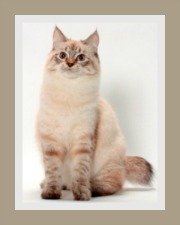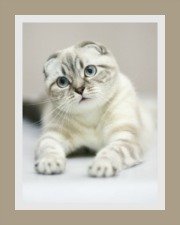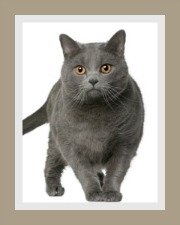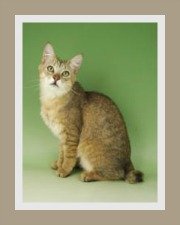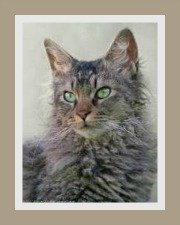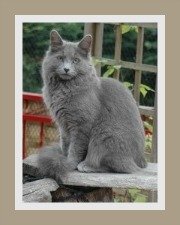Russian Blue Cat
Breed Profile and Facts
The
Russian Blue Cat, along with the Korat and Chartreux cat are known as
the three natural blue-coated cat breeds.
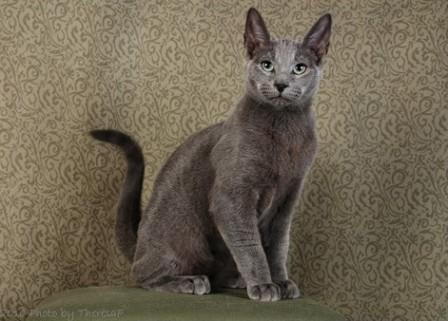
Sp Pr Azreal Xantanah | Russian Blue | bred by Leanne Hewitt | Photo © Theresa Fouche
russian blue information
The breed's features differs in the United Stated and United Kingdom.
The Cat Fanciers' Association (CFA) in the United States and GCCF (Governing Council of the Cat Fancy) in the United Kingdom call for minor variations in all aspects of the cat's features.
Note: the cats featured in the pictures are the British standard
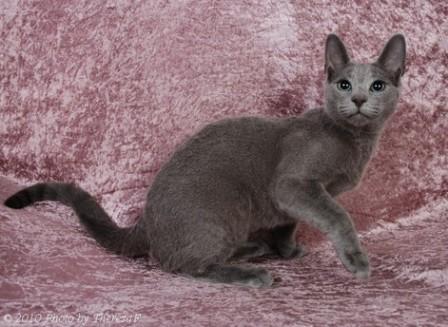
Russian Blue kitten Azreal Sergei Starlin became a Supreme Champion in 2011 | bred by Leanne Hewitt | Photo
© Theresa Fouche
C.F A
|
G.C.C.F
|
|
Russian Blues have plush, double coats with fine, short, silky fur and because of the thickness, the coat stands away from the body. The blue coat should be bright and lighter shades of blue are preferred. Silver-tipped guard hairs gives the coat a lustrous sheen and provides a distinct contrast between the ground color and tipping. |
Russian Blues have plush, double coats with fine, short, silky fur and because of the thickness, the coat stands away from the body. The GCCF calls for a bright blue coat throughout with medium tones and the guard hairs should have no tipping. |
White and Black Russian variants are called Russian Shorthairs and are only recognized by the Australian, New Zealand and South African registries.
|
The body is fine boned, long, muscular and firm, graceful and lithe, never tubular. |
The body is the elegant foreign type without the exaggerated elongation of the Oriental. |
|
Legs are long and fine boned with small rounded paws |
Legs are long and fine boned with oval paws. |
|
The tail is long and straight and in proportion to the body. Moderately thick at the base and tapering to a thin tip. |
The tail is long and straight and in proportion to the body. Moderately thick at the base and tapering to a thin tip. |
|
The head is described as a medium wedge that is neither massive or short. The face is broad and the profile is straight. |
The head is a medium wedge shape and the profile is concave. |
|
The eyes are set wide apart and are rounded in shape and the eye color should be emerald green or vivid green. Kittens will have yellow to green eyes which mature to green at around 1 year. |
The eyes are almond shaped and the eye color should be emerald green or vivid green. Kittens will have yellow to green eyes which mature to green at around 1 year. |
|
Ears are large, set far apart, and broad at the base. Tips are more pointed than they are round. The skin of the ears are translucent, thin and have very little furnishing. |
Ears are large, set far apart, and broad at the base. Tips are more pointed than they are round. The skin of the ears are translucent, thin and have very little furnishing. |
blue russian cat facts
ideal home | ideal family
The Russian Blue cat is a home-loving cat that will tolerate solitude for a while.
It can adapt to indoor living, but is suited to cold weather and the outdoors, provided it is a safe, escape-proof garden.
Most cat lovers will agree that it is preferable to keep a cat indoors as a safety precaution. A cat that is allowed to roam is at risk of been injured by dogs, hostile cats, unfriendly neighbors and motor vehicles.
An outdoor cat is also at greater risk of contracting infectious feline diseases.
A cat that is confined indoors does need sufficient space to exercise and explore and you will need to provide it with a cat-friendly environment filled with toys, cat gyms, cat scratchers and possibly even an indoor garden.
This cat enjoys a calm, quiet environment without upheaval. An ordered existence suits this cat best.
It is a dominant cat and a multi-cat household or a home with toddlers or young children would probably not be suitable for a Russian Blue.
The ideal home would be with a more mature cat-lover. If breeders have raised their kittens under foot in a household with children, the Russian may well adapt to children.
russian blue personality and temperament
Russian Blue cat's temperaments differ from cat to cat, but there are general personality traits.
These dignified cats are lively, athletic, playful and intelligent. They are shy cats and tend to be reserved with strangers.
Russian Blues are dominant cats and hate limits being placed on them. They can be gentle and affectionate but this is reserved for their special owners or people who have earned their trust.
They can be sociable, but it takes time for them to warm to strangers. They do not adjust to change easily and are generally very cautious cats who subscribe to the 'look before you leap' theory.
These cats are not fond of being held or cuddled for long and will wriggle away.
Russian Blues are gentle cats with soft, undemanding voices which they do not use in excess.
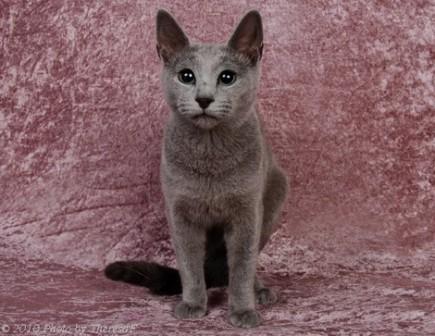
Azreal Safire Satin Sky, kitten, became a Champion in 2011 | bred by Leanne Hewitt. Photo © Theresa Fouche
cat care
Russian Blue cats are easy to care for, in fact, less frequent grooming results in the coat having a deeper sheen whilst over-grooming can damage the coat.
At a change of season when there is excess shedding, remove loose hair by dampening hands with water and stroking the coat.
Visit the chapter on cat care for great tips and advice on cat grooming.
russian blue cat health concerns
Apart from the common infectious feline diseases, which all cats are susceptible to, this is a healthy cat breed with no known genetic health issues.
It is important to vaccinate your cat against feline diseases and to de-worm your cat at least three times a year.
diet | average weight of the russian blue cat
To keep your cat in good condition and healthy, you should feed it the best cat food possible. The chapter on cat food provides excellent information on the different types of feline foods.
Water and not milk is also an essential part of the diet.
The Average Weight
Weight differs between male and female cats, but on average they should weigh between 3.0 - 5.5 kg (7 - 12 lb)
life expectancy of the russian blue
Life expectancy is dependent on numerous factors which are explained in detail in the chapter on how long do cats live.
Generally speaking the average life expectancy of the Russian Blue cat is between 10 - 15 years.
Related Pages:
Top of Russian Blue Cat Page
Return to Domestic Cats
search our site
please like us
share our site
recommend on google
rare cats
